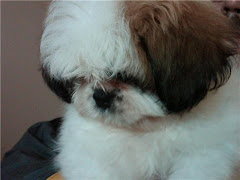
There are several things that you should have on hand for your new puppy. It is best to be prepared. Below is a list of items to have on hand, and some things to do that may help you get ready for your new addition:
1. SAFE AREA: Either a baby or puppy playpen or baby gate to partition a small area. It should be large enough to hold a little bed, a play area, small dish for food and water, with enough room left over to relieve themselves if necessary. Puppies can get into lot's of trouble if they are left unsupervised, so it is necessary to put them in a playpen or other small confined area to keep them safe. This is just a temporary place until the puppy is older and doesn't need quite so much sleep, less mischievous and hopefully housebroken!
2. PUPPY PROOF YOUR HOUSE: Just as you would for a child or baby! You need to move all houseplants, electrical cords, household cleaning supplies, or anything else dangerous near floor level that a small puppy could possible chew on or be harmed by.
3. FOOD: It is best to find out ahead of time what brand of dog food that your puppy has been on, so that you may have a bag ready for them. It is best to keep your puppy on the same diet that it is used to so that it will not be subjected to too many changes at once. Changing to a different food can cause an upset stomach or diarrhea. Any switch in diet should be done gradually by mixing the old food with the new food.
4. NUTRI-CAL: This high calorie dietary supplement in a tube (looks like a tube of toothpaste) is a must have if you are bringing home a tiny toy or teacup size dog. It will help keep a tiny dog or puppy from going into hypoglycemia (low blood sugar). It is also a great source of extra vitamins for any size puppy. It will insure that your puppy is getting some good nutrition while it adjusts to it's new home. A small amount should be given every 6-8 hours for the first 7 days, or until your tiny puppy is settled in and eating well.
4. BOTTLED WATER: You will want to give your puppy bottled water for a few days. Start with pure bottled water and gradually mix in your own water over several days time. Water in different places sometimes vary greatly in the amount of minerals and/or chemicals that they use to purify it with and a big change can sometimes cause stomach trouble or loose stools.
5. CHEW TOYS: It is a good idea to have on hand several types of toys and chew toys to help keep your puppy amused and away from things he shouldn't chew on. Young puppies seem to especially like soft stuffed toys to chew on and sleep with. Dogs have a very keen sense of smell, so we always send a soft toy that smells like our home and siblings along with our puppies when they leave. This seems to help their adjustment, and many people say that years later, this is still their dogs favorite toy. It is also a good idea to give your puppy some harder teething bones or toys too. But remember to only purchase toys that are safe for puppies!
6. BEDDING: A small box or washable plastic surface with a baby blanket in it is usually the best type of bed for your puppy at first. These can be easily cleaned and the blankets thrown in the wash in case of accidents. Many puppies are very clean and would never soil in their bed. But most are too young to know the difference between their bed and any other potty spot and can make quite a mess! Cushy foam beds look adorable, but are best bought after your puppy is housebroken and done teething. It is amazing how one little foam bed can generate so much mess when chewed into a thousand pieces by busy teeth! Also stay away from wicker beds, as wicker will splinter when chewed on and can become lethal to a puppy if swallowed.
7. PUPPY PADS: Puppy pads or " Wee wee" pads are good to have on hand for your puppy to relieve themselves on. Since puppies should be kept away from other dogs, and from parks or grass that other dogs have been around until they have finished all their shots (4 months of age), many people are choosing to litter box train their small pups. Most puppies we place have already been started on newspaper training. To litter box train, it is usually easiest to start with a litter box lined with newspaper or piddle pads.
8. BOWLS: You will need a shallow food bowl and a semi-shallow water bowl for your puppy. Do not use a bowl that is deep, especially for water, because it is possible for a small puppy to fall in or even drown. Also they cannot reach if the water or food level gets too low.
Alejandra Esquinca pics.

No comments:
Post a Comment